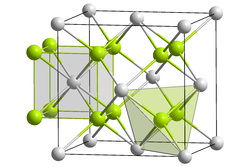Plutonium (IV) oxide
| Crystal structure | |||||||||||||||||||
|---|---|---|---|---|---|---|---|---|---|---|---|---|---|---|---|---|---|---|---|

|
|||||||||||||||||||
| __ Pu 4+ __ O 2− | |||||||||||||||||||
| Crystal system | |||||||||||||||||||
| Space group |
Fm 3 m (No. 225) |
||||||||||||||||||
| Lattice parameters |
a = 540 pm |
||||||||||||||||||
| Coordination numbers |
Pu [8], O [4] |
||||||||||||||||||
| General | |||||||||||||||||||
| Surname | Plutonium (IV) oxide | ||||||||||||||||||
| other names |
Plutonium dioxide |
||||||||||||||||||
| Ratio formula | PuO 2 | ||||||||||||||||||
| Brief description |
yellow-brown cubic crystals |
||||||||||||||||||
| External identifiers / databases | |||||||||||||||||||
|
|||||||||||||||||||
| properties | |||||||||||||||||||
| Molar mass | 276.06 g mol −1 | ||||||||||||||||||
| Physical state |
firmly |
||||||||||||||||||
| density |
11.5 g cm −3 |
||||||||||||||||||
| Melting point |
2400 ° C |
||||||||||||||||||
| boiling point |
2800 ° C |
||||||||||||||||||
| solubility |
poorly soluble in acids |
||||||||||||||||||
| Hazard and safety information | |||||||||||||||||||
 Radioactive |
|||||||||||||||||||
|
|||||||||||||||||||
| As far as possible and customary, SI units are used. Unless otherwise noted, the data given apply to standard conditions . | |||||||||||||||||||
Plutonium (IV) oxide , usually referred to as plutonium dioxide , is the most chemically stable oxide of plutonium . It is a crystalline yellow-brown solid with a high melting temperature.
properties
Plutonium dioxide is not very reactive and is hardly attacked by water or salty water. It can also be sintered into ceramic material .
Plutonium dioxide has a cubic crystal system , the space group Fm 3 m (No. 225) , the unit cells have a lattice parameter of a = 540 pm , the structure type is the CaF 2 type ( fluorite ) and the coordination numbers are Pu [8], O [4].
Plutonium dioxide is an olive-green to gray-green powder. Single crystals, which can be obtained from the melt or from the decomposition of plutonium (IV) sulfate , for example , are available as black, shiny crystals. Microspheres, which can be created by melting plutonium dioxide powder in a plasma flame, are red-brown to amber-yellow.
presentation
Plutonium dioxide is created spontaneously by the oxidation of plutonium metal in an oxidizing atmosphere at normal temperature and pressure.
In the reprocessing of nuclear fuel rods , it is obtained by plutonium (IV) oxalate hexahydrate or decahydrate at temperatures from 1000 ° C calcined is. It is also formed when plutonium (IV) nitrate and plutonium peroxide are heated .
use
Sintered plutonium dioxide is used in radionuclide batteries and is used as a material for fuel rods .
safety instructions
Classifications according to the CLP regulation are not available, although the chemical toxicity of plutonium is known. The dangers based on radioactivity are important . Depending on the type of plutonium isotopes used, plutonium dioxide is radioactive in different ways and, due to the heat generated during radioactive decay , it is also hot in short-lived alpha emitters .
Individual evidence
- ↑ a b c David R. Lide (Ed.): CRC Handbook of Chemistry and Physics . 90th edition. (Internet version: 2010), CRC Press / Taylor and Francis, Boca Raton, FL, Properties of the Elements and Inorganic Compounds, pp. 4-81.
- ↑ plutonium dioxide at www.webelements.com .
- ↑ a b c Georg Brauer (ed.), With the collaboration of Marianne Baudler a . a .: Handbook of Preparative Inorganic Chemistry. 3rd, revised edition. Volume II, Ferdinand Enke, Stuttgart 1978, ISBN 3-432-87813-3 , p. 1305.
- ↑ The hazards emanating from radioactivity do not belong to the properties to be classified according to the GHS labeling. With regard to other hazards, this substance has either not yet been classified or a reliable and citable source has not yet been found.
- ↑ Tilmann Althaus: "Cassini and the nuclear energy", in: Sterne und Weltraum , 1998 , 37 (3), pp. 220-223.
- ↑ saturn.jpl.nasa.gov: Environmental Effects of Plutonium Dioxide ( Memento of the original from September 29, 2006 in the Internet Archive ) Info: The archive link was inserted automatically and has not yet been checked. Please check the original and archive link according to the instructions and then remove this notice. (PDF; 30 kB).
literature
- David L. Clark, Siegfried S. Hecker , Gordon D. Jarvinen, Mary P. Neu: Plutonium , in: Lester R. Morss, Norman M. Edelstein, Jean Fuger (Eds.): The Chemistry of the Actinide and Transactinide Elements , Springer, Dordrecht 2006; ISBN 1-4020-3555-1 , pp. 813-1264 ( doi : 10.1007 / 1-4020-3598-5_7 ).


